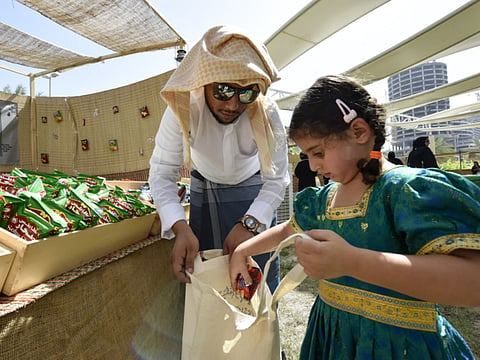What is Hag Al Laila? All you need to know about the Emirati tradition
Sweet treats, special songs and family fun – this night is specially dedicated to children

Dubai: ‘Atoona Hag Al Laila’ … if you hear some young voices loudly singing outside your house, it can only mean one thing – you’re going to be parting with some sweets and candies very soon.
The Emirati tradition of Hag Al Laila, which falls on the 15th day of the Hijri month of Shaban, comes with a special experience that brings communities together – young children go around the neighbourhood, paper bags in their hands, receiving some sweet treats, or in some exceptional cases, even some money. The tradition is observed on the 15th night of Sha'ban and this year it will happen on Friday, February 14.
But what is this tradition of Hag Al Laila and how can you participate in the festivities? Here is all you need to know.
Traditions around Hag Al Laila
Hag Al Laila, which means ‘for the night’, is marked in the middle of Shaban, the month that precedes Ramadan.
The tradition is also celebrated in other countries, but is referred to by different names. In Qatar it is called Garangao; in Bahrain it is called Gergaoon; in Oman it is called Garangesho, and in Kuwait and Saudi Arabia, it is called Gargean.
Children are a big part of the celebration. They dress up in traditional clothes and carry colourful woven bags, and have special songs, which they sing while on their trip around the neighbourhood. You might find them outside the door, simply saying ‘Atoona Hag Al Laila’, which means ‘Give us sweets for tonight’ or saying ‘Atoona Allah yaa’teekoum bet Makah yewadeekoum,’ which means ‘Give to us and God will give to you, and, with His grace, you will visit Makkah’.
According to Ahmed Al Jafflah, Protocol Manager and Senior Presenter at Sheikh Mohammed Bin Rashid Al Maktoum Centre for Cultural Understanding (SMCCU), the celebrations help children learn about the significance of being in a community, encourage the spirit of generosity and prepare everyone for all the good that is in store for them during the month of Ramadan.
“As children go around the neighbourhood, the lady will come out of the house and offer them the basket filled with sweets and nuts. The children take one handful of that sweet and put it in their paper bags. Then they go to the next house and do the same.”
As children go around the neighbourhood, the lady will come out of the house and offer them the basket filled with sweets and nuts. The children take one handful of that sweet and put it in their paper bags. Then they go to the next house and do the same.

Talking about the care families take in making sure children have fun gathering their sweets, he said: “When you are a kid you have a small hand … so, some families put a little cup to help the children get more sweets. Others might even hand out money.
“It is basically a celebration for the children, for them to be happy and visit homes of family members and their neighbours. It is meant to prepare them for the happiness of what is going to come in Ramadan,” he added.
Family time
During Hag Al Laila, families also get together and make special dishes, like luqaimaat or fried dumplings soaked in date honey, which are usually reserved for special occasions like Eid or weddings.
“I remember when we were children, my mother would make luqaimaat and give us the date syrup, which we would pour on top of it and eat. I still remember when once, my mum had asked me to sit with her while she was frying the luqaimaat and told me to make sure that I cover the pot when she put some fried luqaimaat into it. After some time, she noticed that the pot was not getting full. That’s when she realised I was eating all the luqaimaat. That’s one fond memory I have from Hag Al Laila as a child,” he said.
If you would like to try your hands at making this special Emirati dish at home, check out our setp-by-step guide here.
How can you participate in the festivities?
Al Jafflah advised people to keep some sweets ready to share with children during the week, especially if they have Emirati families living in the neighbourhood.
“You will find children knocking at your door … you should have some sweets or perhaps some packets of chips ready for them. It will make their day,” he said.
This article was originally published on March 6, 2023 and has been updated since.
Sign up for the Daily Briefing
Get the latest news and updates straight to your inbox



